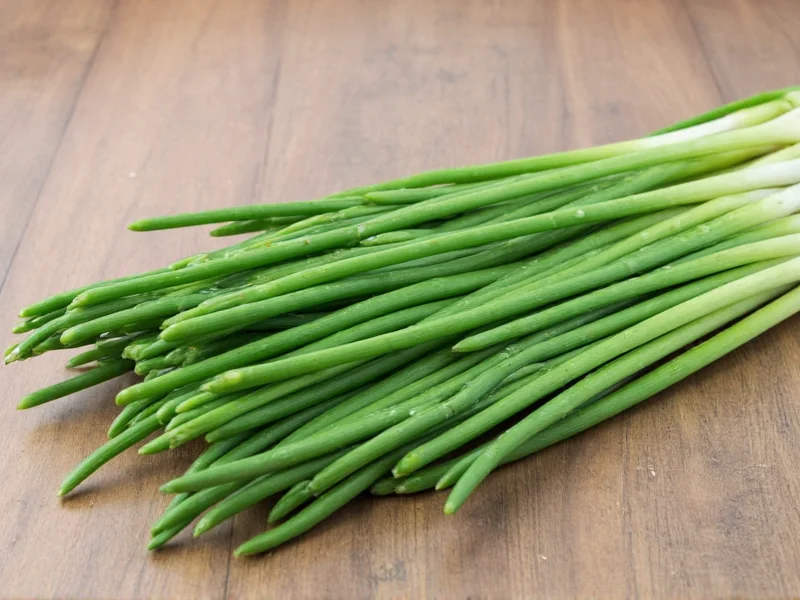Running out of chives mid-recipe doesn't have to ruin your dish. These versatile onion-family members bring a delicate, mild flavor to everything from soups to salads, but several accessible alternatives can maintain your recipe's integrity when fresh chives aren't available. Understanding which substitute works best depends on your specific dish, desired flavor intensity, and what's already in your pantry.
Top Chive Substitutes Ranked by Effectiveness
When searching for the best chive substitute for soup or other dishes, consider these options in order of similarity to fresh chives:
1. Green Onions (Scallions)
Green onions are the closest fresh chive replacement, offering a similar mild onion flavor with slightly more bite. Use the green parts only for the most authentic substitution. They work exceptionally well as a chive substitute in potato salad or creamy dips. For most recipes, substitute green onions for chives at a 1:1 ratio, but reduce slightly if you prefer a milder flavor.
2. Shallots
Shallots provide a more complex, slightly sweeter onion flavor that works beautifully in dressings and sauces. When using shallots as how to substitute chives in salad dressing, use half the amount called for chives since they're more potent. Finely mince shallots and let them sit for 10 minutes before using to mellow their sharpness.
3. Garlic Chives
Don't confuse these with regular chives—they have a distinct garlic flavor alongside the onion notes. Perfect when you want to add garlic complexity, like in Asian stir-fries or garlic bread. Substitute at a 1:1 ratio, but recognize you're adding garlic notes your recipe might not have originally intended.
4. Fresh Dill
While not onion-flavored, dill offers a similar delicate texture and fresh finish. Best for fish dishes, cucumber salads, or sour cream-based dips where the flavor profile complements rather than replicates chives. Use slightly less dill than chives called for, as its flavor is more pronounced.
5. Fresh Parsley
Parsley provides the right visual appeal and mild freshness when chives are unavailable. It lacks the onion flavor but works well as a garnish substitute for chives in soups and plated dishes. Use flat-leaf (Italian) parsley for best results at a 1:1 ratio.
| Substitute | Ratio vs. Chives | Best For | Flavor Notes |
|---|---|---|---|
| Green onions (scallions) | 1:1 (green parts only) | Salads, dips, baked potatoes | Mild onion flavor, slightly stronger than chives |
| Shallots | 1:2 (use half amount) | Dressings, sauces, roasted vegetables | Sweeter, more complex onion flavor |
| Garlic chives | 1:1 | Stir-fries, garlic bread, Asian dishes | Distinct garlic-onion combination |
| Chive powder | 1:3 (1 tsp powder = 1 tbsp fresh) | Dry rubs, spice blends, soups | Concentrated onion flavor, less fresh |
| Onion powder | 1:4 (1/4 tsp powder = 1 tbsp fresh) | Cooked dishes, stews, casseroles | Stronger, more pungent flavor |
Dried vs. Fresh Chive Substitutes
When considering chive substitute dried vs fresh options, remember dried alternatives lack the delicate freshness of raw chives but work well in cooked dishes. Chive powder maintains the closest flavor profile among dried options. For every tablespoon of fresh chives, use one teaspoon of chive powder. Onion powder makes an acceptable last-resort substitute but use sparingly—¼ teaspoon replaces one tablespoon of fresh chives—as its flavor is much more intense.
Never substitute dried regular chives for fresh at a 1:1 ratio; this common mistake results in overpowering, unpleasant dishes. The drying process concentrates flavors significantly, requiring careful measurement.
Best Substitutes for Specific Dishes
Different recipes demand different substitution approaches. Knowing what to use instead of chives in specific applications ensures your dish maintains its intended character:
- Cold dishes (salads, dips, dressings): Green onions or finely minced shallots work best, added at the end of preparation to preserve freshness
- Hot soups and stews: Shallots or chive powder added during cooking; green onions stirred in just before serving
- Baked potatoes: Green onions provide the most similar visual and flavor profile
- Omelets and scrambled eggs: Shallots or green onions cooked with the eggs for integrated flavor
- Cold cucumber soup: Dill offers complementary flavor notes when chives aren't available
What NOT to Use as Chive Substitutes
Avoid these common substitution mistakes when seeking chives replacement options:
- Regular onions: Too strong and pungent, especially raw—they'll dominate your dish
- Leeks: While related, they require extensive cooking and have a different texture
- Chives frozen for long periods: They lose texture and develop off-flavors
- Excessive dried substitutes: Results in bitter, overpowering flavors
Storage Tips for Fresh Substitutes
Maximize the shelf life of your chive alternatives with these techniques. Store green onions upright in a glass with an inch of water, covered with a plastic bag in the refrigerator—they'll stay crisp for 10-14 days. Shallots keep best in a cool, dark pantry for 1-2 months. For emergency substitutions, freeze minced shallots or green onions in ice cube trays with water or oil for quick access when fresh chives aren't available.











 浙公网安备
33010002000092号
浙公网安备
33010002000092号 浙B2-20120091-4
浙B2-20120091-4